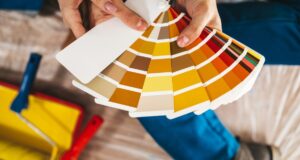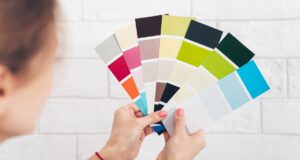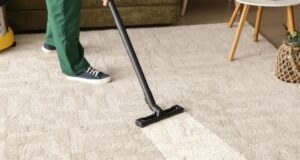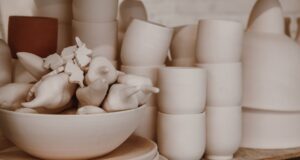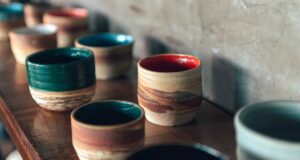A simple way to turn your matte glaze glossy
Do you have a matte glaze that you wish was a bit glossier, or would you like a glossy version of one of your matte glazes? It’s really easy to convert a matte glaze to a glossy glaze, just by adding one ingredient – Silica (SiO2).
The 3 photos above are pairs of test tiles where the only difference between each pair is the addition of Silica.
Matte glaze on the left + Silica = glossy glaze on the right. Pretty cool, right?
To get more specific, let’s look at the recipes. These are screenshots from glazy.org
Calcium matte

Calcium gloss

A look at the recipes
The first thing to look at is the percentages for each material. The Whiting is the same, the Neph Sy is the same, the EPK is the same, the Frit is the same, but the Silica has 40 more grams (per 100g) in the glossy version than the matte version.
That’s literally the only change that was made to the matte glaze to make it glossy. So, if I were to make 100g of this matte glaze and then add 40g of Silica, I get a glossy glaze. And that’s exactly what I did to create the test tiles at the top of this article.
The next thing to notice is the recipe totals at the bottom. The matte glaze adds up to 100 and the glossy glaze adds up to 140. I could have normalized the glossy formula so that it also adds up to 100. This would re-calculate the totals for each ingredient to make them all a percentage of 100. But I left it this way to make the change obvious when I go back and look at it in the future.
A look at the chemistry
The following image shows the 2 glazes plotted on the Stull chart (named after the scientist who developed it in 1912). This chart takes the UMF of a glaze recipe and plots the Silica level (SiO2) on the x-axis and the Alumina level (Al2O3) on the y-axis. On the Stull chart, the only variables are Silica and Alumina. Fluxes and Boron remain constant throughout.
I have colour coded the regions of the chart to make it easier to see the patterns. The green region is where the matte glazes are found, the pink region is where the glossy glazes are found, and the yellow region is somewhere between matte and glossy. The turquoise regions are underfired.
Stull’s original research was done at cone 11, but I have re-created this chart by firing 50 tests with varying Silica and Alumina values at cone 6 and the patterns are generally the same. My tests also contained Boron, which is required to bring the melting temp down from cone 11 to cone 6. You can learn more about Stull’s chart and my cone 6 research
In order to understand where these points came from, let’s look at the recipes again. This time with the UMF included above the recipe. Check out the values for SiO2 and Al2O3.
Calcium matte

Calcium gloss

In both recipes, the Al2O3 is the same at 0.46. This makes sense because we didn’t change any of the ingredients that contain Al2O3. We only increased the Silica, which is pure SiO2.
In the matte glaze, the SiO2 is at 2.17. In the glossy glaze, the SiO2 is at 4.12.
More Silica added = higher SiO2. These highlighted UMF values are what I plotted on the Stull chart.
With Al2O3 levels being the same, the points are plotted on the same horizontal line because we are only changing the x-axis (SiO2) values. Anytime you add straight Silica to a recipe, you will move horizontally to the right on the Stull chart.
Another thing to look at in the UMF is where it says SiO2:Al2O3. This is the Silica:Alumina Ratio and it’s given as a numerical value that represents the number of Silica molecules for every Alumina molecule in the formula.
The matte glaze has a SiO2:Al2O3 ratio of 4.72. This means that for every molecule of Al2O3 in the glaze recipe, there are 4.72 molecules of SiO2. For the glossy glaze, the ratio is 8.98 molecules of SiO2 for every molecule of Al2O3. It’s this ratio that determines whether a glaze is likely to be matte or glossy. As the SiO2:Al2O3 ratio goes up, a glaze will move from matte to glossy.
But you can’t keep adding Silica forever. Adding Silica raises the melting temp of your glaze. Eventually the glaze will have too much Silica to melt and it will be underfired.
What you will generally find is:
SiO2:Al2O3 = 5 or less —> matte glaze
SiO2:Al2O3 = 5 to 6 —> “satin” glaze (between matte and glossy)
SiO2:Al2O3 = 6 to 12 —> glossy glaze
SiO2:Al2O3 = over 12 —> underfired glaze
Will adding Silica turn every matte glaze glossy?
No, not every matte glaze will turn glossy with the addition of Silica. As with everything in ceramics, there are some exceptions and nuances to be learned, but there’s a pretty simple criteria that will tell you if this method is likely to work.
All you have to do is take your matte glaze recipe and use glaze calculation software to look at the UMF (Unity Molecular Formula). My favourite way to do this is at glazy.org.
Create a free account first if you don’t have one, and then enter your matte glaze recipe. Glazy will convert your glaze recipe to UMF and also plot it on the Stull chart.
If your matte glaze falls into the matte region of the Stull chart, then you have what I call a “Stull Matte” glaze and this method of adding Silica is very likely to work.
How to adjust your “Stull Matte” glaze
All you have to do is add enough Silica to move the point on Stull to the right and into the glossy region.
You can do this by making a copy of your matte glaze in Glazy.org and then just use the + button to increase the Silica as you watch the dot move to the right across the Stull chart. Voila! You have re-formulated your matte glaze to be a glossy glaze.
If you want your matte glaze to be satin, or only slightly glossy, just add a small amount of Silica. This will move the dot only slightly to the right on the Stull chart. Typically a SiO2:Al2O3 ratio between 5 and 6 will give you a satin glaze. If it’s too matte, add some Silica. If it’s too glossy, remove some Silica. Testing is always required to get the exact result you’re looking for.
If you want it to be glossy, aim for a SiO2:Al2O3 ratio of between 7 and 10. Once your SiO2:Al2O3 ratio approaches 12, your glaze is at risk of becoming underfired.
If your glaze isn’t a “Stull Matte” glaze
If your matte glaze does NOT fall within the matte region of Stull, then adding Silica might not make it glossy. Some glazes are matte because they contain titanium, which crystallizes during the cooling cycle. Adding Silica to a titanium matte glaze won’t necessarily make it glossy. It might, it just depends how much titanium is in the recipe as well as where it falls on the Stull chart. Doesn’t hurt to try it.
Other glazes are matte because they’re underfired. An underfired glaze appears matte because it hasn’t melted into glass yet. Adding Silica to an underfired glaze definitely won’t make it glossy because adding Silica raises the melting temperature. If your matte glaze falls in the glossy region of Stull and does not contain titanium, there’s a good chance it’s underfired.
Look at the images below. The matte glazes are in the 1st photo. See how the glazes are slightly runny? And then the glossy glazes in the 2nd photo aren’t runny at all. This shows how increasing Silica raises the melting temperature of a glaze.





